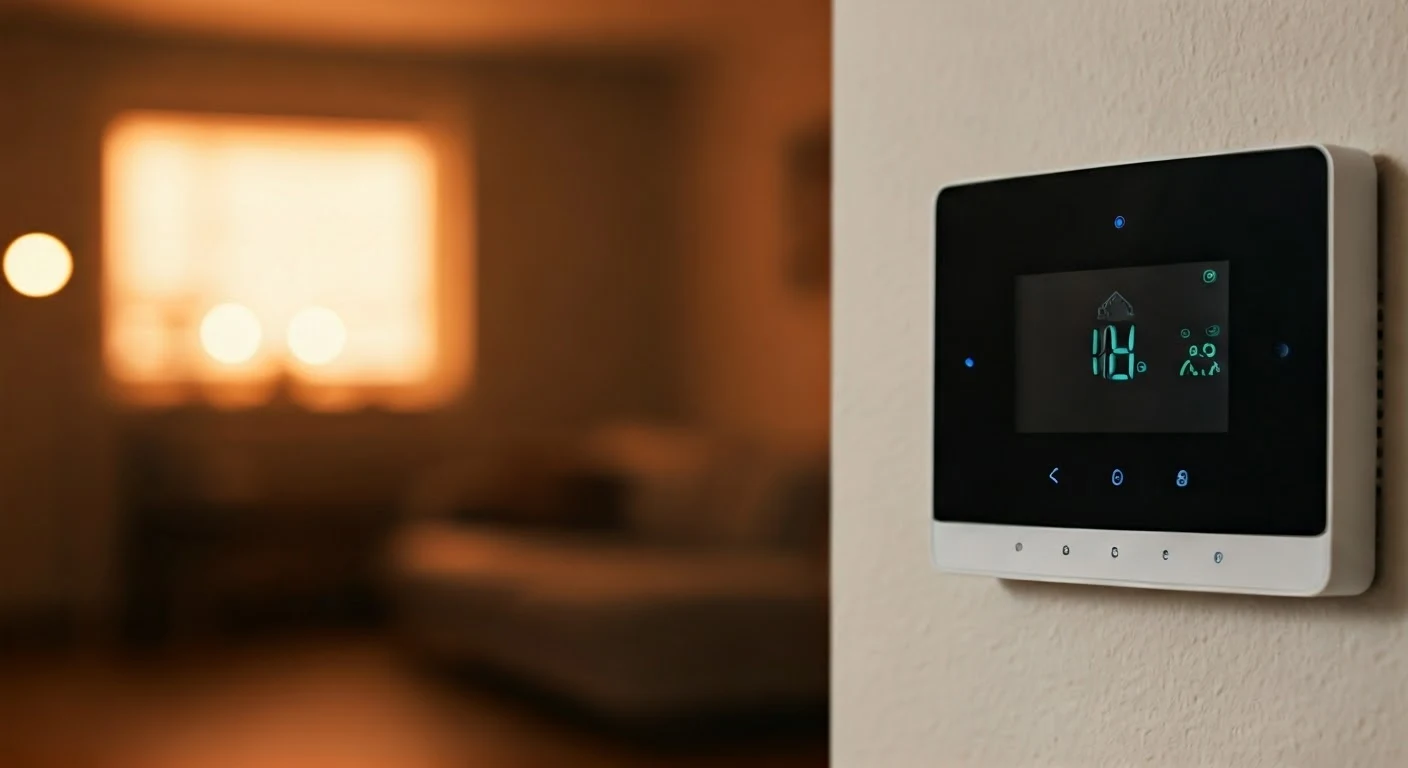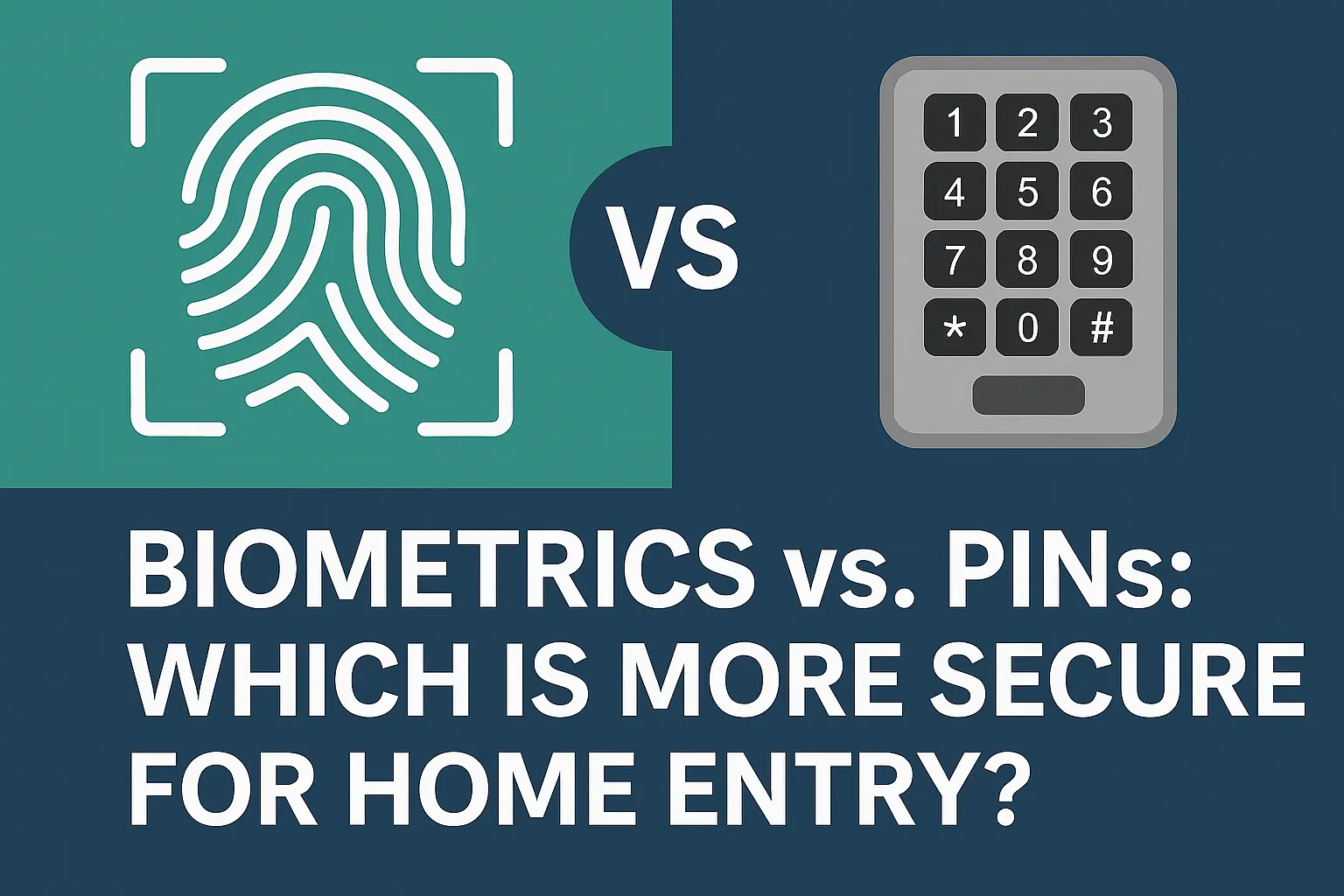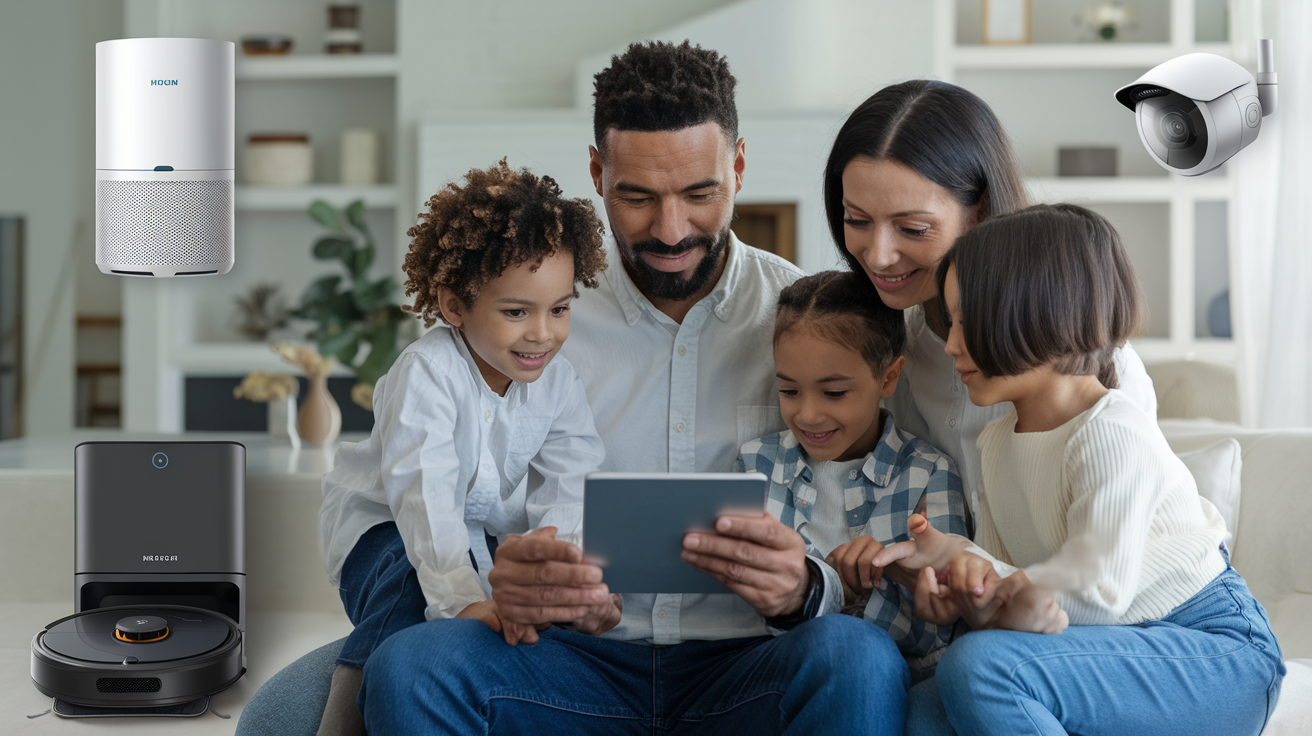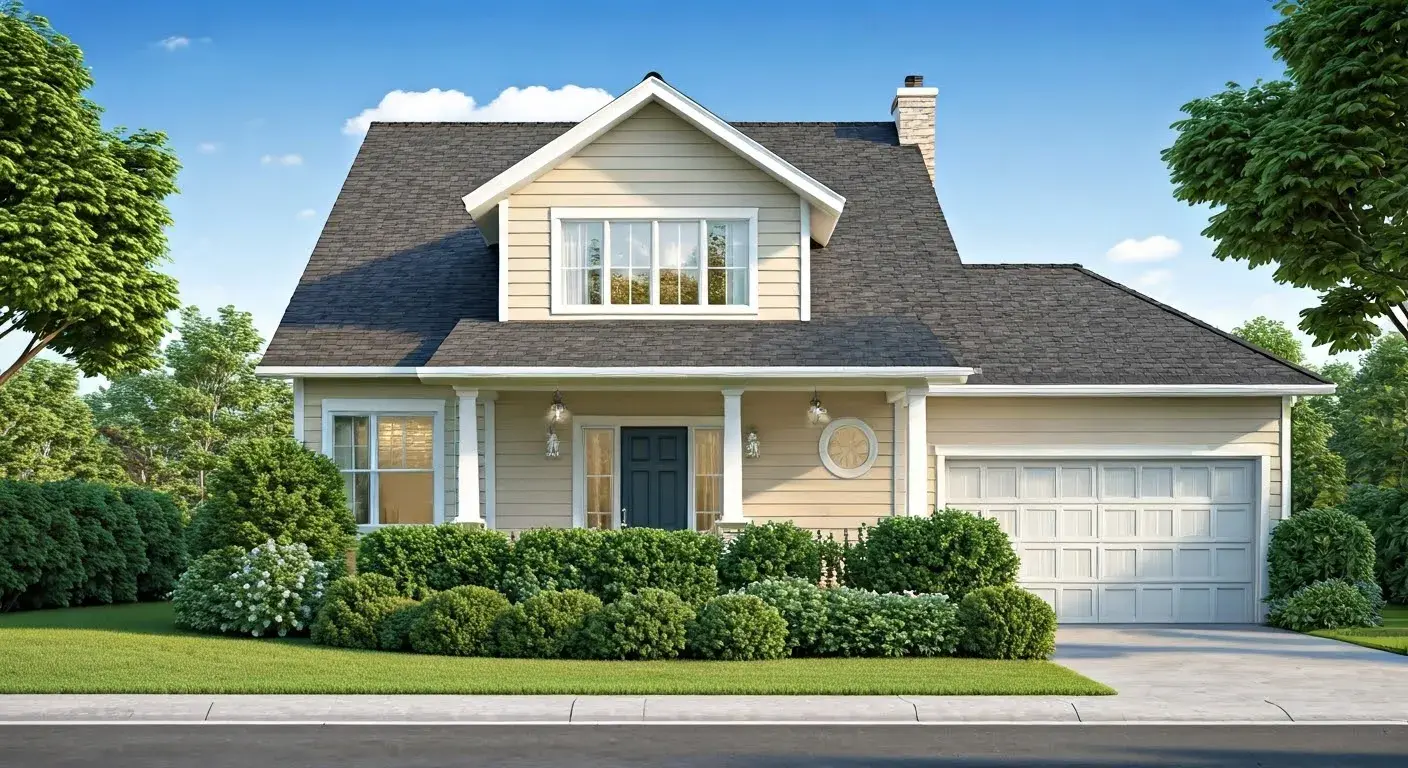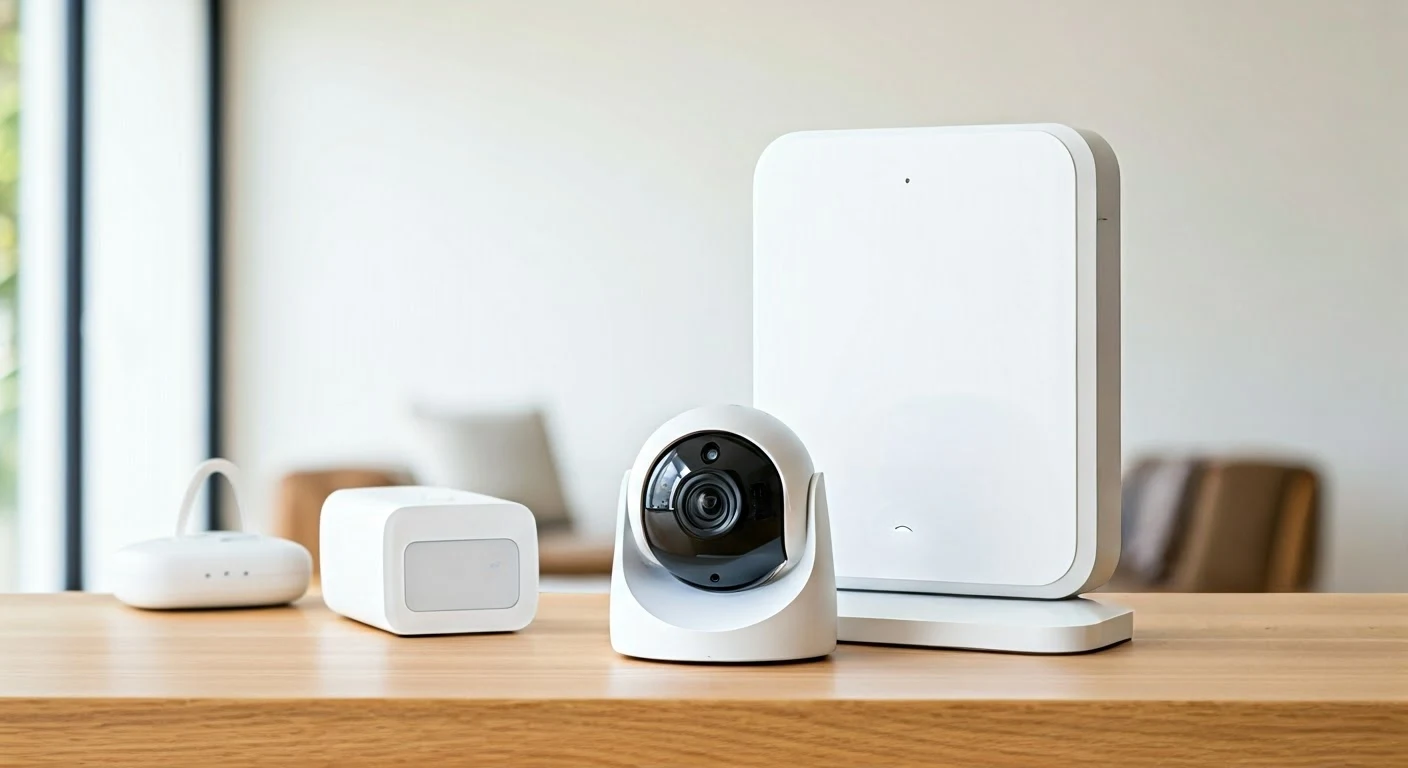In our connected world, smart home security is now a must-have, not just a luxury. Today's advanced systems, like the Arlo home security system, do more than regular alarms. They offer complete solutions to protect your home and family. This includes professional monitoring, real-time alerts, and links to other smart home devices. When you invest in a smart home security system, you get peace of mind. You can rest easy knowing your home is safe all day and night.
Understanding Smart Home Security Alarm Systems
A smart home security system turns your house into a safe place. It links different security devices to a main hub, such as the Vivint Smart Hub. This hub is like the brain, helping sensors, alarms, cameras, and more to work together.
With an easy mobile app, you can take control of your smart home security system from anywhere. You can arm or disarm the system, get instant alerts, watch live cameras, and even set it up to respond to special events, including receiving push notifications – all right from your phone.
The Evolution of Home Security
Home security has changed a lot from the old lock-and-key methods. In the past, people used simple alarm systems with wired connections. These systems were often not very useful. As time went on, technology improved our home security methods.
Then came wireless technology. This changed everything. Security systems began to use wireless sensors, motion detectors, and outside cameras. This made it easier to cover larger areas and it offered more options.
Now, we live in the age of the smart home. Today’s security systems use the internet, smartphones, and artificial intelligence. This brings us better protection, convenience, and control over our home security.
Key Components of a Smart Home Security System
At the heart of every smart home security system is the base station with a motion sensor. This central hub connects all the other parts. It serves as the control center for your whole security setup.
From the base station, you can manage several important security devices:
- Motion detectors check for movement in a specific area. They send alerts if they notice any suspicious activity.
- Door and window sensors notify you right away when a door or window is opened or damaged.
- Security cameras, both indoor and outdoor, give live video feeds and recordings. This lets you watch over your property.
Choosing the Right Smart Home Security Alarm System
Choosing the right smart home security alarm system requires you to think about a few key things. First, look for the best smart home security system that works well with your current smart devices. This makes it easy to control everything and set up automation.
Next, focus on systems that are easy to use. They should have clear apps and simple setup steps. Finally, pick a well-known provider that offers great customer service. This way, you can get help whenever you need it.
Factors to Consider Before Making a Purchase
Cost: Look at the initial costs for equipment and ongoing costs. Professional monitoring plans generally have a monthly fee. Self-monitored systems might need a cloud storage subscription.
Monitoring Options: Think about whether you want self-monitoring or professional monitoring. Professional monitoring gives you help all day, every day, and quicker emergency responses, but it costs more.
Features and Reliability: Check the features, such as video storage choices, how you can change notification settings, and how good the system is at reducing false alarms.
Top Brands in the Market Today
The smart home security market is brimming with innovative smart home equipment solutions. Google Nest offers seamless integration with Google Assistant and Google Home devices, making it a popular choice for those invested in Google's ecosystem.
Amazon's Ring Alarm provides affordable options and wide compatibility with various smart home devices, particularly entry sensors and Amazon Alexa devices. Abode systems cater to users seeking extensive customization and integration with third-party platforms, boasting HomeKit compatibility and IFTTT support.
| Brand | Key Features | Ideal For |
| Google Nest | Google Assistant integration, user-friendly app | Google Home users |
| Ring Alarm | Affordable, Alexa compatibility | Budget-conscious, Alexa users |
| Abode Systems | Customization, HomeKit, IFTTT support | Tech-savvy, integration seekers |
Installation and Setup of Your Smart Home Security System
Many smart home security systems today are made for easy do-it-yourself (DIY) setup. Most parts, such as sensors and detectors, are wireless. They can be installed with sticky tape or a little drilling. Usually, the mobile app helps you out with the steps clearly, and some require a monthly plan for full functionality.
If you would rather have someone do it for you, many companies provide professional installation for an extra charge. This makes sure all parts are placed correctly. It also helps you feel good knowing your system is properly set up.
DIY vs. Professional Installation Options
Choosing between a DIY system and a professional installation depends on your comfort and budget. A DIY system can save you money and lets you customize the system the way you like. But, it needs some technical skills and careful placement of sensors to work well.
The professional installation offers an expert setup. This way, everything works perfectly. It takes away the stress of doing it yourself. Plus, you get ongoing customer service and technical support from the provider.
In the end, think about professional installation. This is a good choice if you want a complete system with a professional monitoring plan. It's also great if you want advanced features or need expert help.
Step-by-Step Guide to Setting Up Your System
Setting up your smart home security system is easy and involves a few steps. First, pick a central location for your base station. This station works as the command center for your system. Make sure it is close to your Wi-Fi router for a good connection.
Next, download the mobile app for your system on your smartphone or tablet. This app is important for managing your smart home security, changing settings, and getting notifications.
Lastly, use the app to connect all your security devices like sensors, cameras, and alarms to the base station. Many systems also provide a web dashboard, which lets you control your system from a computer. This is a good option if you do not want to use the mobile app.
The Role of AI and Machine Learning in Enhancing Home Security
Artificial intelligence and machine learning are changing home security for the better. They make security systems smarter and more proactive. By looking at past events and environmental factors, predictive analytics can find potential threats before they happen. Moreover, machine learning helps these systems get better at their job over time.
Security systems with AI can tell the difference between real threats and false alarms. This cuts down on unnecessary alerts and makes the system work better. They learn your daily habits, recognize who belongs at home, and adjust to your routines. This creates a personalized and smart security experience for you.
Predictive Analytics for Preventing Break-ins
Imagine a security system that not only reacts to threats but also helps stop them before they happen. That’s what predictive analytics can do. By looking at data from different sources, AI-powered systems can spot patterns and unusual activity that may show a possible break-in.
For instance, a system with facial recognition can tell the difference between familiar faces and strangers near your home. If it sees an unknown person, it sends you real-time alerts. AI also considers things like the time of day, weather, and local crime rates to provide better risk assessments.
This proactive way of thinking improves home security. It helps you find possible issues before they become bigger problems. You can then take action or call the authorities quickly.
Customizing Your Security Alerts with AI
Gone are the days of getting confusing security alerts. Now, AI makes your security notifications more personal. It sorts out the unimportant events and gives you the important stuff only.
For example, you can set up your smart home security system to send alerts only if it sees movement in certain areas while you are not at home. It will ignore any activity in other spots. AI can also tell the difference between the sound of a window breaking and your pet knocking over a vase. This helps cut down on false alarms from everyday life.
With this careful setup, you can be aware of real security issues without being overwhelmed by constant notices. This gives you peace of mind and clear information.
Integration with Other Smart Home Devices
One big benefit of smart home security systems is how well they connect with other smart home features. This lets you set up a smart home where your security system talks to other smart devices, like smart locks, smart lights, and thermostats.
For instance, you can set your system to turn on the smart lights when it sees motion. You can also make your thermostat change the temperature when you arm or disarm the security system. Using voice control makes it even easier. You can manage your security just by talking to your favorite voice assistant.
Creating a Unified Smart Home Ecosystem
Integrating your security system into a larger home automation setup offers many options. Picture this: your security system senses you coming home after work. It then disarms, unlocks your smart lock, turns on the lights, and sets the thermostat to your favorite temperature – all by itself.
You can make this happen by connecting your security system to other smart home products. Popular voice assistants like Amazon Alexa, Google Assistant, and Apple HomeKit act as main hubs. They help you control many devices, allowing you to manage everything about your smart home, including security, with one simple interface.
Bringing your smart home devices together creates a more comfortable and convenient atmosphere. It can also save energy and improve your security, giving you peace of mind.
Compatibility with Voice Assistants and Mobile Apps
Most smart home security systems work well with popular voice assistants like Google Assistant, Amazon Alexa, and Apple HomeKit. This means you can use your voice to control your security system.
For example, you can tell Google Assistant to arm your system when you leave. You can also ask Alexa to show you live video from your security camera on a smart display. Additionally, you can use voice commands to lock your smart lock, change your thermostat, or get updates on your security.
Also, mobile apps give you great control over your smart home security system. You can manage settings, watch live video feeds, get notifications, and check recorded footage right from your phone.
The Benefits of Remote Monitoring and Control
A smart security system changes how we protect and connect with our homes, including the ability to oversee your front door. You can check your home security from anywhere. This gives you peace of mind and control while you are at work, on vacation, or just away from home.
With the mobile app, you can arm or disarm your security from a distance, providing ease of use. You can also view live video from your cameras. The app lets you receive quick notifications and control other smart devices with just a few taps on your smartphone.
Accessing Your Home Security System from Anywhere
You don’t have to stay close to a physical control panel to keep your home safe anymore. With cloud-connected systems, you can check and control your security from anywhere with the internet.
The mobile app acts as your virtual command center and comes with useful features like:
- Live video streaming: You can see what's happening at your property in real time, no matter where you are.
- Remote arming and disarming: With just one tap, you can turn your system on or off, even if you are far away.
- Cloud storage access: You can look at past recordings stored safely in the cloud to see events or check alarm messages.
Real-time Alerts and Notifications
Real-time alerts are very important for a good smart home security system. These instant messages keep you updated about what happens as it occurs. This helps you to act fast or call the right people if needed.
Imagine you get a message on your phone right when your security camera sees movement or when a door or window sensor goes off. These quick alerts help you check on the situation and decide what to do. You can figure out if it's a false alarm, look at your property from afar, or call emergency services.
You can change the settings for these alerts to suit your needs. This way, you can stay informed without getting too many messages. It helps give you peace of mind without bothering you all the time.
Security Measures Beyond Burglary Protection
Smart home security systems do more than protect against burglary. They provide many safety features that go beyond just keeping intruders out. You can add sensors for smoke, carbon monoxide, and water leaks to build a comprehensive system for your home.
These sensors alert you early about possible dangers. This lets you act fast, reduce damage, and keep your family safe. Some systems can even call emergency services, like the fire department or medical help, if there is an emergency.
Fire, Flood, and Carbon Monoxide Monitoring
Smart home security systems with environmental sensors give your home more safety. They protect against fire, flood, and carbon monoxide risks.
Smart smoke alarms work with your system to send immediate alerts to your phone if they detect smoke or fire. This gives you valuable time to respond. Flood sensors should be placed in higher-risk areas, like basements or close to appliances. They will warn you about water leaks before serious damage happens.
It's also very important to monitor carbon monoxide. Smart CO detectors that are part of your system warn you early about this gas, which is colorless and odorless. This lets you leave your home and find fresh air as soon as possible.
Emergency Response Features
In a critical situation, every second is important. Smart home security systems with professional monitoring services are a key part of safety. They can ensure help is only a button away.
When an alarm goes off, the monitoring center will try to contact you. They want to check if the alarm is real. If you can't answer or confirm there is a problem, they will send emergency services to your home right away. This could be police, fire departments, or medical help.
Also, many smart home security systems, including an outdoor camera, have battery backup. This means your security system will still work even if the power goes out. This gives you ongoing protection and peace of mind, no matter what is happening outside.
Keeping Your Smart Home Security System Secure
As our homes connect more with technology, we need to focus on the security of our smart devices. Smart home security systems can be at risk of online dangers, just like any other device that uses the internet.
To protect your system, choose strong and unique passwords for all your accounts. Also, turn on two-factor authentication if you can. Make sure to update your system's firmware regularly and install security patches as soon as they are available. This way, you can fix any weak spots and keep hackers away.
Protecting Against Hackers and Digital Threats
As you add more smart devices to your home, it’s important to be careful about cyber security. You should take steps to keep your smart home security system safe from hackers and online threats.
Start by choosing a good provider that has a history of strong security measures. Look for systems that use encryption to keep the data safe when it moves between devices and the cloud. This helps protect your personal information from unauthorized access.
Make sure to regularly update your system’s firmware. Install security patches to fix any weak spots and stay ahead of possible threats. Be careful when giving access to third-party apps and services. Only allow those from trusted sources that are known for good security and privacy.
Regular Updates and Security Patches
In the world of cyber threats, keeping your software up to date is very important for the safety of your smart home security system.
Firmware updates and security patches come out from time to time. These updates help fix problems, improve performance, and protect against new threats. If you don’t apply these updates, your system could be at risk, and your home security might be weakened.
Make sure to check for updates often. You can do this using the mobile app, web dashboard, or by reaching out to the support team. By staying on top of software maintenance, you can lower the chance of security issues and make sure your smart home security system keeps your home and loved ones safe.
The Future of Smart Home Security Systems
Emerging technologies are changing how we think about home security. They promise to make our homes safer and more connected. Technologies like artificial intelligence, machine learning, and the Internet of Things will help improve home safety a lot.
In the future, we can expect trends like early threat detection and more personalized security for our homes. Smart home security will become closely linked with other smart home systems. Plus, 5G technology will make a big difference by providing quicker responses, more data capacity, and better communication between devices.
Emerging Technologies and Trends
The future of smart home security is full of exciting options. New technologies are making way for smarter and more active security systems. Biometric scanners, like fingerprint and facial recognition, improve safety by allowing only approved people to enter.
There is a growing number of IoT devices. They gather lots of information that smart systems can use. Think about a time when your security system will look at data from your smart doorbell, outdoor lights, and even local weather reports. This way, it can spot possible dangers and act before any issue occurs.
AI and machine learning are making security even better. They can learn your habits and recognize your routines. Because of this, they can set alerts just for you. This reduces false alarms and keeps you updated about real threats.
The Impact of 5G on Home Security
The rollout of 5G networks is set to change smart home security for the better. It offers super-fast speeds, lower delays, and better connections. This means a more effective and reliable security system for your home.
With 5G, security systems can react faster. They can send data and alerts almost immediately. This helps you get important alerts quickly. You can make decisions faster, which might lead to a quicker emergency response.
Better connections through 5G allow you to easily add more smart home devices to your security setup. This creates a smarter security network. It can monitor and respond to many types of events and threats for better home security.
Conclusion
In conclusion, a smart home security alarm system is an important investment. It helps protect your home and your loved ones. New technologies like AI and machine learning make these systems better. They offer features like remote monitoring and real-time alerts to keep things safe. When you connect these systems with other smart devices and voice assistants, you get a smooth smart home experience. Think about leading brands and installation details to stay ahead of possible risks. Choose a reliable smart alarm system for your home security that keeps you safe and sound.
